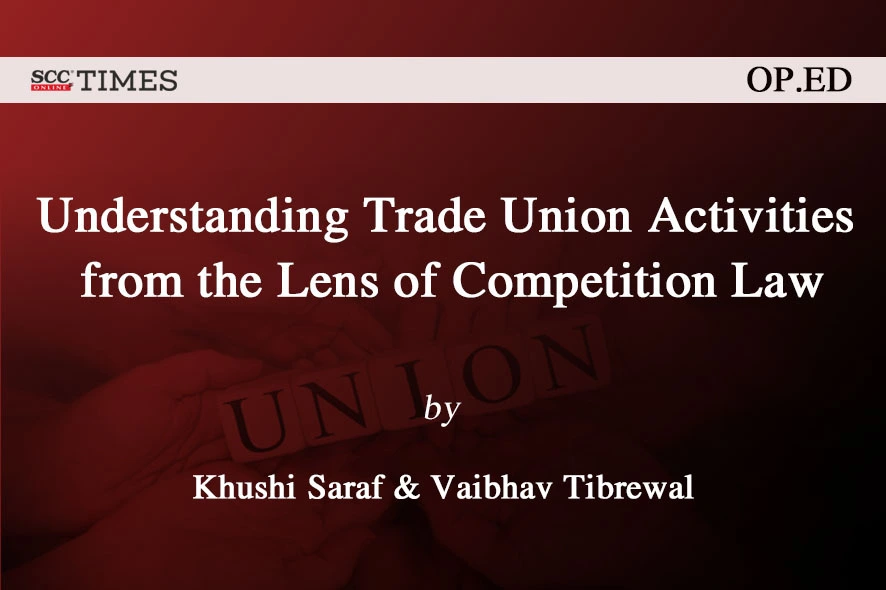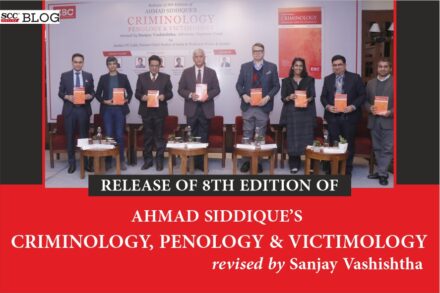Introduction
The issue of balancing competition laws and labour laws objectives requires one to foster a dynamic market where economic efficiency and consumer welfare run parallel to workers’ rights. Against that backdrop, one of the most pressing concerns that emerge is the cartelisation of trade unions in the name of collective bargaining. The Competition Act, 2002 (the Act)1, unlike its predecessor,2 does not expressly exempt trade unions from its ambit, leaving the question of exemption ambiguous. In that regard, there is an emerging debate in the legal and academic circles that a blanket exemption should be given to trade unions,3 putting workers’ rights and social policy objectives of labour laws above the consumer welfare objectives of trade unions. Such arguments have based this idea of a blanket exemption on the ground that multiple other countries have allowed for the same and a similar approach should be adopted in India.4
The present paper argues that a blanket exemption ought not to be given to trade unions in India. Part II of the paper discusses two important issues (trade unions acting with business interests and trade unions in dominant sectors) associated with trade union activities and how they raise competition law concerns. Against the back of these issues, Part III analyses the same from the perspective of exclusive agreements (akin to close shop agreements) to understand the inevitable problems associated with trade union activities, creating serious antitrust concerns. Part IV further makes a case against a blanket exemption as the same would violate the proportionality principle while balancing the competition law policy with social objectives of trade unions encompassing workers’ rights in the Indian legal framework. Part V concludes.
Trade union activities leading to cartelisation in the market
It is well-established in Indian competition law that collective bargaining by trade unions is legal only if there are demonstrable competitive effects.5 One of the primary goals of competition law stands to be consumer welfare, as reflected in the Preamble of the Act.6 The Act also puts an obligation on the Competition Commission of India (CCI) to eliminate practices that can adversely affect the competition in the market, promote and sustain competition, protect consumer interest and ensure that freedom of trade is protected in the Indian markets.7 Given that the objective of most of these trade unions is securing better conditions for their members, the reality remains that there is a very minor difference between lawful and unlawful trade union activities. Judicial precedents suggest that when trade unions forgo their legal obligations and engage in collective or collusive decision-making with the objective of limiting or controlling the production, distribution, sale, price, etc. it amounts to antitrust violations.8 Activities of trade unions like fixing prices,9 or raising prices10 through concerted action, regulating and limiting the availability and distribution of goods or services,11 mandating membership to the association for a particular area,12 and collectively boycotting businesses or organisations,13 have been held to be anti-competitive.
In this paper, the authors discuss two pertinent perspectives that exacerbate the issue of collective bargaining by trade unions, raising competition law concerns.
A. Legitimate trade union activities versus trade unions acting in a concerted, coordinated manner
Collective bargaining is a method of dispute resolution where issues related to employment conditions are resolved in a peaceful manner by agreement instead of coercion.14 It is well-recognised that legitimate activities of trade unions, including collective bargaining and protests, are protected under Article 1915 of the Constitution.16 These trade union activities are quintessential for improving workers’ conditions and ensuring fair labour standards. However, when trade unions act in a concerted and coordinated manner, like calling for a boycott affecting the competition, then it cannot get away under the garb of trade unionism, and such activities must necessarily be adjudicated based on the provisions of the Act.17 Trade unions exploiting their position to distort market practices would fall under the ambit of the Act. A similar argument has been discussed by Routh, who believes that trade unions, insofar as they promote constitutional principles of solidarity, are exempted from the Act. However, when they act with a profit motive or a business interest of their own, then the associations would be deemed as cartels.18
B. Trade unions in dominant markets
The situation is particularly dire in those sectors where trade unions largely dominate the market in the name of setting regulations and standardisation.19 For instance, the pharmaceutical sector, and entertainment and media industry are some of the most penalised sectors in India. Given the fragmented nature of these sectors, it is easier for smaller firms and individuals to form associations, increasing the chances of collusive behaviour.20 A substantial chunk of collusive activities witnessed in the industry suggests that they force new entrants into signing no objection certificate (NOC) documents and follow specific guidelines set by the associations, such as dealing only with those businesses that have been allotted to them.21 If the members do not follow the guidelines, they face risks of potential boycotts. The same is true for associations in the film and entertainment industry as well, where these associations limit the supply and distribution of films, violating Section 3(3)22 of the Act.23 Ergo, in certain sectors, unions are particularly strong, and they dominate labour relations, wielding considerable influence in terms of hiring practices and dominating labour relations. Herein, the question of potential misuse of any blanket exemption becomes particularly relevant owing to such a scenario.
The aforementioned perspectives are crucial to understand the next part of the paper where the issue of exclusive agreements by trade unions has been discussed in the film industry.
Trade unions engaging in exclusive agreements
Trade unions imposing restrictions on employers to hire only unionised workers is a crucial reason that mandates for trade unions not to be given blanket exemptions under the Act. This is known as a closed-shop agreement,24 where trade unions impose restrictive conditions on employers amounting to exclusive dealing contracts. One such agreement existed in Vipul A. Shah v. All India Film Employee Confederation (Vipul Shah)25, where the Artists’ Association entered in memorandum of understandings (MoUs) with film producers demanding that the producers only hire those artists who were members of the Artists’ Association and effectively restricted non-members from being engaged by the producers (member-to-member agreement). It also required the producers to inform the Association if the producers hired a non-member, and such hiring was allowed only after it issued NOC. The hiring conditions essentially mandated that these persons necessarily join the Association in order to work with the producers. They also mandated a 30% work requirement for certain shows where producers will have to give work to junior artists and Mahila Kalakar Sangh member affiliates of the Artists’ Association. Additionally, a Vigilance Committee was set in place, which ensured that the producers complied with these conditions and imposed penalties in case of non-compliance. These conditions created a restraint on the hiring practices of producers. The CCI found such practices to be anti-competitive under Section 3(3)(b) of the Act, and were held to impose undue restrictions on film producers to hire artists as per their desire.
Along the same line, in Reliance Big Entertainment Ltd. v. Karnataka Film Chamber of Commerce, the CCI found such member-to-member agreements to have been restrictive for the non-members to effectively compete in the market,26 regardless of their skills and qualifications. Moreover, it also affects their right to freedom of association, for it compels workers to join trade unions to get work from a particular employer.27 Since the employers are afraid of penalties or boycotts,28 their compliance with the demands of trade unions affects the right to livelihood of non-unionised workers as are unable to seek employment solely due to their non-membership with the trade union in question.
These cases reflect a trend of how trade union activities severely restrict the freedom of employers to acquire services of their choice, and how they manipulate the hiring process of the employers, limiting and controlling the market. It is pertinent to understand that being restricted to hire only from a specific pool of workers not only inflates the labour costs,29 but also restricts the ability of employers to negotiate wages or terms outside the union’s influence. Allowing trade unions to exert significant control over labourers’ wages through these exclusive agreements may invariably lead to price fixing, reducing competition in the broader market.30 These member-to-member agreements also create entry barriers for non-unionised workers, limiting their mobility. For the purposes of this paper, the authors have only discussed the antitrust concerns with respect to exclusive agreements, but several other concerns have been increasingly emerging. It is these concerns that arise in the guise of collective bargaining that make it crucial that trade unions not be granted a blanket exemption.
Treading the path carefully: Blanket exemption is against the proportionality principle
This part of the paper discusses the position of a blanket exemption in the European Union (EU), and differentiates the same from the Indian position. This part further justifies the need to bring trade unions under the ambit of the Act for it aligns with the proportionality principle.
A. Relevance of the proportionality principle
The Supreme Court in Coimbatore District Central Coop. Bank v. Employees Assn. has held that the doctrine of proportionality is an accepted principle in the Indian legal framework, and has defined proportionality in the following manner:31
18. “Proportionality” is a principle where the Court is concerned with the process, method or manner in which the decision-maker has ordered his priorities, reached a conclusion or arrived at a decision. The very essence of the decision-making consists in the attribution of relative importance to the factors and considerations in the case. The doctrine of proportionality thus steps in focus true nature of exercise the elaboration of a rule of permissible priorities.
19. De Smith states that “proportionality” involves “balancing test” and “necessity test”. Whereas the former (balancing test) permits scrutiny of excessive onerous penalties or infringement of rights or interests and a manifest imbalance of relevant considerations, the latter (necessity test) requires infringement of human rights to the least restrictive alternative.
The Supreme Court held that principle of proportionality is a manner by which a priority is defined for a decision to be taken. “Balancing test” means that the infringement of the rights should not be too harsh. There must be a proper balance between the rights and the limitations.32 “Necessity test” signifies that any limitation in the rights will be done in a least restrictive manner.
This proportionality principle must be used to take decisions when interests of competing parties are at stake. The balancing test is applied in a manner such that the decision which results in the least infringement of rights should be accorded to. Since a decision under the proportionality principle is taken after a balanced approach, a weighed analysis of the social objectives of trade union and competition policy is inevitably conducted.33 As discussed above, the proportionality principle is followed for creating a hierarchy in decision-making. Hence, between the competition law policy and the social policy objectives of trade unions, wherever least infringement occurs, the decision is given favouring that policy.
A similar approach is undertaken in the EU while dealing with proportionality wherein an order should not go beyond necessary curtailment of rights and the burden imposed should not be excessive.34 Article 5 of the Treaty on the European Union (TEU) establishes that the principle of proportionality regulates the exercise of EU competences, ensuring that the content and form of EU actions adhere to proportionality.35 In that regard, the authors staunchly believe that an approach based on the proportionality test would result in a higher weightage being accorded to the competition laws in India, while under the EU this approach would result in a higher weightage to social objectives of trade unions. The subsequent section will discuss the same.
B. Contrasting position of the law in EU and India
In both EU and India, the social policy objectives of trade unions conflict with the competition law policy. A blanket exemption of the trade unions from the competition law paradigm envisages a complete subjugation of the antitrust laws for the accomplishment of the social objectives of a trade union. This approach is reflected in Albany International BV v. Stichting Bedrijfspensioenfonds Textielindustrie (Albany), where the Court toed a line between labour law and competition law; social policy in the labour law promoted collective bargaining and agreements, while competition policy could potentially restrict them.36 The Court of Justice of the European Union (CJEU) held that the goals of social policy take precedence over those of the competition policy in the EU law under the “principle of proportionality”.37 CJEU referred to the EU laws such as Articles 11838 and 239 of the Erstwhile European Community (EC) Treaty, and Article 1 of the Social Policy to show that high weightage is accorded to social policy of trade unions.40 Article 118 of the EC Treaty states that the Commission is responsible for fostering collaboration between Member States on the rights of workers and employers to form associations and engage in collective bargaining. Furthermore, Article 118b states that the Commission must promote dialogue between management and labour at the European level, which could, result in agreement-based relations. A reading of these laws shows that the EU accords high value to collective bargaining. Thus, the CJEU concluded that if an agreement is the result of negotiations between the workers and the employers, then competition law cannot be applied for it promotes social objectives.41 Therefore, primacy of social policy objective of labour laws is central to the decision in Albany42.
The application of the principle of proportionality has been seen in the Indian jurisprudence as well. However, unlike the EU, where it tilted in favour of trade unions, in India, it would tilt in favour of the competition authorities.
An analysis of the Trade Unions Act, 192643, suggests that trade unions are not given an exempted from competition law.44 The ambit of the Act is very broad and it is given the character of a socio-economic legislation which protects the market from unfair practices in tandem with the preamble.45 Sections 18 and 60 of the Act, bestows immense power to India’s competition policy.46 As per Section 18, the CCI is bound to eliminate practices which have a detrimental impact on the market. Furthermore, Section 60 grants an overriding authority over other laws, meaning that any inconsistencies with existing statutes will not invalidate the provisions of the Act in question. As a result, the CCI’s power to conduct investigations and its expansive jurisdiction over the specified issues extends the scope of its involvement in business matters. This has also been followed in cases like Super Cassettes Industries v. Union of India47, where it was held that in a case of conflict between the Copyright Act, 195748 and the Competition Act,2002 the authority shall vest with the CCI to determine the issue of jurisdiction.
Traces of the doctrine of proportionality can also be seen in Vipul Shah49, where the CCI undertook the jurisdiction of the case and held certain activities of trade unions to be anti-competitive. Clauses related to fixation of wages, payment for extra shifts, etc. which are inherently tied to conditions of labours were held to have fallen within legitimate trade union activities. Thus, the CCI refused to delve into those issues as they also affected the labour market and the social policy objectives of trade unions. This is an apt example where the Indian competition authority adopted a balanced approach to weigh the conflicting goals of competition law and labour law. This case demonstrates an awareness of the CCI that competition policy cannot be disregarded purely in the name of protecting trade union objectives. Thus, the case also acknowledges that the Indian competition authorities are allowed to adjudicate over issues of trade unions in cases of market distortions, and the same should be accepted and a blanket exemption cannot be envisaged in that light.
Conclusion
It is imperative that trade unions be held accountable for affecting the market supply and distribution. By examining the potential anti-competitive effects of exclusive agreements by trade unions, the authors have demonstrated that unchecked trade union activity can result in market distortions. Thus, creating a blanket exemption for trade unions under competition law, as has been suggested by the existing literature, is not a feasible option in India. It would also go against the proportionality principle which acts as a guiding framework for balancing the social objectives of trade unions with the broader goals of competition law.
*3rd year student, BA LLB (Hons.), The West Bengal National University of Juridical Sciences (WBNUJS)
**3rd year student, BA LLB (Hons.), The West Bengal National University of Juridical Sciences (WBNUJS)
2. Monopolies and Restrictive Trade Practices Act, 1969.
3. Vasu Aggarwal and Pratyush Singh, “Need for Exemptions for Trade Unions under Indian Competition Law”, (2022) 15(2) NUJS Law Review; Sanvid Tuljapurkar and Tejaswi Reddy Dokaru, “Collective Bargaining under Competition Law”, Indian Competition Law Review (iclr.in, 2016).
4. Vasu Aggarwal and Pratyush Singh, “Need for Exemptions for Trade Unions under Indian Competition Law”, (2022) 15(2) NUJS Law Review; Sanvid Tuljapurkar and Tejaswi Reddy Dokaru, “Collective Bargaining under Competition Law”, Indian Competition Law Review (iclr.in, 2016).
5. FICCI — Multiplex Assn. of India v. United Producers/Distributors Forum, 2011 SCC OnLine CCI 33.
7. Competition Act, 2002, S. 18.
8. Vipul A. Shah v. All India Film Employee Confederation, 2017 SCC OnLine CCI 53.
9. Bengal Chemist and Druggist Assn., In re, 2014 SCC OnLine CCI 39.
10. Builders Assn. of India v. Cement Manufacturers’ Assn., 2012 SCC OnLine CCI 43.
11. Manju Tharad v. Eastern India Motion Picture Assn., (2012) 114 SCL 20 (CCI).
12. Ghanshyam Dass Vij, In re, 2015 SCC OnLine CCI 174.
13. FCM Travel Solutions (India) Ltd. v. Travel Agents Federation of India, 2011 SCC OnLine CCI 77.
14. Karnal Leather Karamchari Sanghatan v. Liberty Footwear Co., (1989) 4 SCC 448.
15. Constitution of India, Art. 19.
16. Cinemax India Ltd. v. Film Distributors Assn., 2014 SCC OnLine CCI 194.
17. CCI v. Coordination Committee of Artistes and Technicians of W.B. Film and Television, (2017) 5 SCC 17; Cinemax India Ltd. v. Film Distributors Assn., 2014 SCC OnLine CCI 194.
18. Supriya Routh, “Workers and Competition Law in India: Worker’ Associations are Mostly Not Cartels”, Cambridge University Press, 2022, Ch. 13.
19. Vincent S. Abraham and Catarina Marvão, Leniency of the Competition Commission of India (cci.gov.in).
20. Vincent S. Abraham and Catarina Marvão, Leniency of the Competition Commission of India (cci.gov.in).
21. Vincent S. Abraham and Catarina Marvão, Leniency of the Competition Commission of India (cci.gov.in).
22. Competition Act, 2002, S. 3(3).
23. Competition Commission of India, Market Study on the Film Distribution Chain in India (cci.gov.in, 14-10-2022); UTV Software Communications Ltd. v. Motion Pictures Assn., 2012 SCC OnLine CCI 34;
24. Toke Aidt and Zafiris Tzannatos, Unions and Collective Bargaining: Economic Effects in a Global Environment, The World Bank (documents1.worldbank.org, 2002).
25. Vipul A. Shah v. All India Film Employee Confederation, 2017 SCC OnLine CCI 53.
26. Reliance Big Entertainment Ltd. v. Karnataka Film Chamber of Commerce, 2012 SCC OnLine CCI 169 : (2012) 108 CLA 116.
27. Labour Law and Employment Manual (wieta.org.za, 2013).
28. Reliance Big Entertainment Ltd. v. Karnataka Film Chamber of Commerce, 2012 SCC OnLine CCI 169.
29. David Card, “The Effect of Unions on the Structure of Wages: A Longitudinal Analysis”, (1996) 64 Econometrica 957-979.
30. OECD, Competition Concerns in Labour Markets — Background Note (one.oecd.org).
31. Coimbatore District Central Coop. Bank v. Employees Assn., (2007) 4 SCC 669, 678.
32. Christian Medical College Vellore Assn. v. Union of India, (2020) 8 SCC 705.
33. Shaun Bradshaw, “Collective Agreements and EU Competition Law: Do We Need an Exemption?”, D. Phil., University of East Anglia (2019).
34. R. v. Secretary of State for Health, ex p British American Tobacco (Investments) Ltd. and Imperial Tobacco Ltd., Case C-491/01, ECLI:EU:C:2002:741, 2002 ECR I-11453.
35. Treaty on European Union (TEU) (adopted on 12-12-2007, entered into force on 1-11-1993), Art. 5(4).
36. Case C-67/96, 1999 ECR 1-5751.
37. Shaun Bradshaw, “Collective Agreements and EU Competition Law: Do We Need an Exemption?”, D. Phil., University of East Anglia (2019).
38. European Community Treaty, 1957, Art. 118.
39. European Community Treaty, 1957, Art. 2.
40. Maastricht Protocol on Social Policy, (adopted on February 7, 1992) OJ 1992 C 191, Art. 1, p. 91; Albany International BV v. Stichting Bedrijfspensioenfonds Textielindustrie, Case C-67/96, 1999 ECR 1-5751.
41. Albany International BV v. Stichting Bedrijfspensioenfonds Textielindustrie, Case C-67/96, 1999 ECR 1-5751; Trade Unions Act, 1926.
42. Case C-67/96, ECR 1-5751.
44. Vipul A. Shah v. All India Film Employee Confederation, 2017 SCC OnLine CCI 53.
45. Sanvid Tuljapurkar and Tejaswi Reddy Dokaru, “Collective Bargaining under Competition Law”, (2016) Indian Competition Law Review (iclr.in).
46. Competition Act, 2002, Ss. 18 and 60.
47. 2015 SCC OnLine Del 10841.
49. Vipul A. Shah v. All India Film Employee Confederation, 2017 SCC OnLine CCI 53.






